
Thurmond is a town in Fayette County, West Virginia, United States, on the New River. The population was five at the 2020 census. During the heyday of coal mining in the New River Gorge, Thurmond was a prosperous town with a number of businesses and facilities for the Chesapeake and Ohio Railway.

Baltimore Penn Station—formally, Baltimore Pennsylvania Station—is the main inter-city passenger rail hub in Baltimore, Maryland. Designed by New York City architect Kenneth MacKenzie Murchison (1872–1938), it was constructed in 1911 in the Beaux-Arts style of architecture for the Pennsylvania Railroad. It is located at 1515 N. Charles Street, about a mile and a half north of downtown and the Inner Harbor, between the Mount Vernon neighborhood to the south, and Station North to the north. Originally called Union Station because it served the Pennsylvania Railroad and Western Maryland Railway, it was renamed to match the PRR's other main stations in 1928.
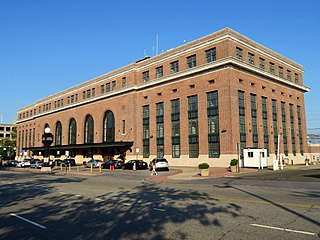
New Haven Union Station is the main railroad passenger station in New Haven, Connecticut. It is the third such station in the city of New Haven, preceded by both an 1848 built station in a different location, and an 1879 built station near the current station's location. Designed by noted American architect Cass Gilbert, the present beaux-arts Union Station was completed and opened in 1920 after the previous Union Station was destroyed by fire. It served the New York, New Haven and Hartford Railroad for the next five decades, but fell into decline following World War II along with the United States railroad industry as a whole.

The Central of Georgia Railway started as the Central Rail Road and Canal Company in 1833. As a way to better attract investment capital, the railroad changed its name to Central Rail Road and Banking Company of Georgia. This railroad was constructed to join the Macon and Western Railroad at Macon, Georgia, in the United States, and run to Savannah. This created a rail link from Chattanooga, on the Tennessee River, to seaports on the Atlantic Ocean. It took from 1837 to 1843 to build the railroad from Savannah to the eastern bank of the Ocmulgee River at Macon; a bridge into the city was not built until 1851.

Richmond Main Street Station, officially the Main Street Station and Trainshed, is a historic railroad station and office building in Richmond, Virginia. It was built in 1901, and is served by Amtrak. It is also an intermodal station with Richmond's city transit bus services, which are performed by Greater Richmond Transit Company (GRTC). The station is colloquially known by residents as The Clock Tower. It was listed to the National Register of Historic Places in 1970, and in 1976 was made a U.S. National Historic Landmark. Main Street Station serves as a secondary train station for Richmond providing limited Amtrak service directly to downtown Richmond. Several Amtrak trains serving the Richmond metropolitan area only stop at the area's primary rail station, Staples Mill Road which is located five miles to the north in Henrico County.
The Western Railway of Alabama (WRA) also seen as "WofA" was created as the Western Railroad of Alabama by the owners of the Montgomery & West Point Railroad (M&WP) in 1860. It was built to further the M&WP's development West from Montgomery, Alabama to Selma, Alabama. When the line was constructed in 1870, the M&WP was merged into the WRA, creating a line from Selma to West Point, Georgia. It served Auburn, Alabama and connected in Opelika, Alabama to the Central of Georgia line from Columbus, Georgia to Birmingham, Alabama. Although it was partially owned by the Central of Georgia around the turn from the nineteenth to the twentieth century, it did not end up being owned by Norfolk Southern when that company came into existence due to the merger of the CofG's parent, the Southern Railway, and the Norfolk & Western Railway.
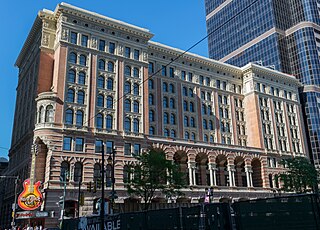
The Reading Terminal is a complex of buildings that includes the former Reading Company main station located in the Market East section of Center City in Philadelphia, Pennsylvania, United States. It comprises the Reading Terminal Headhouse, Trainshed, and Market.
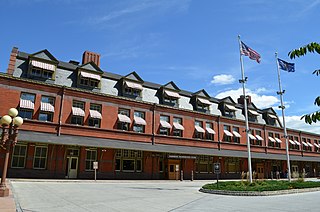
The Harrisburg Transportation Center is a railway station and transportation hub in Harrisburg, Pennsylvania. It is located on the eastern edge of Downtown Harrisburg between the intersections of Aberdeen and Market Streets and 4th and Chestnut Streets.

Savannah station is an Amtrak train station in Savannah, Georgia. It serves the Floridian, Palmetto, and Silver Meteor; it is the southern terminus of the Palmetto. The station has one island platform and one side platform which together serve two main tracks and one siding of the Savannah Subdivision.

Union Station, also called the Meridian Multi-Modal Transportation Center, is an intermodal transportation center in Meridian, Mississippi. The station is located at 1901 Front Street in the Union Station Historic District within the larger Meridian Downtown Historic District, both of which are listed on the National Register of Historic Places. Consisting of a new addition and renovated surviving wing of the 1906 building, Union Station was officially dedicated on December 11, 1997. It is a center of several modes of passenger transportation, including Amtrak train service on the Norfolk Southern rail corridor, Greyhound, and other providers of bus services.

Montgomery Union Station and Trainshed is a historic former train station in Montgomery, Alabama. Built in 1898 by the Louisville and Nashville Railroad, rail service to the station ended in 1979 and it has since been adapted for use by the Montgomery Area Visitor Center and commercial tenants. It was added to the National Register of Historic Places in 1973 and became a National Historic Landmark in 1976.

Thurmond station is a train station in Thurmond, West Virginia, United States, that is served by Amtrak, the national railroad passenger system. The Cardinal, which runs three times each week between Chicago, Illinois and Washington, DC, passes by the station three times each week in both directions. The station is on CSX Transportation's New River Line and is located on the east bank of the New River.
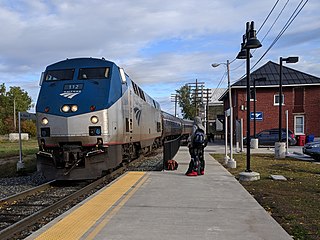
St. Albans station is an Amtrak train station in St. Albans, Vermont, United States. It is the northern terminus of the daily Vermonter service.
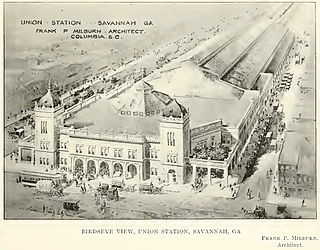
Savannah Union Station was a train station in Savannah, Georgia. It was located at 419–435 West Broad Street, between Stewart and Roberts Streets. It incorporated the Atlantic Coast Line Railroad, the Seaboard Air Line Railroad and the Southern Railway. While the term, union station, in the United States generally implies a station that hosts all train companies stopping in a city, the Central of Georgia and the Savannah and Atlanta Railway used other stations in Savannah.

The Georgia State Railroad Museum is a museum in Savannah, Georgia located at a historic Central of Georgia Railway site. It includes parts of the Central of Georgia Railway: Savannah Shops and Terminal Facilities National Historic Landmark District. The complex is considered the most complete antebellum railroad complex in the United States. The museum, located at 655 Louisville Road, is part of a historic district included in the National Register of Historic Places.

Central of Georgia Railway Company Shop Property is the former administration building of the Central of Georgia Railway. The site complex includes several notable structures, including a freight house, a cotton yard with brick gates which it shares with the Central of Georgia Depot and Trainshed, and a brick viaduct leading to a junction with the line along Louisville Road west of Boundary Street and the Savannah and Ogeechee Canal. The tracks were also located next to "The Gray Building," a Greek Revival structure built in 1856, which the C&G moved their headquarters to. This building became known as "The Red Building."

The Southern Railway Spencer Shops are a former locomotive repair facility in Spencer, North Carolina. The shops were one of the Southern Railway's primary maintenance facilities. The shops were built in the 1890s and named after Southern Railway president Samuel Spencer. Following dieselization, the need for the Spencer Shops diminished, and the facilities were decommissioned in the 1970s. The Spencer Shops and associated land were donated by the Southern Railway to the state of North Carolina, which established the North Carolina Transportation Museum on the site.
Central of Georgia Railroad Terminal or Central of Georgia Depot may refer to:

The SCAD Museum of Art was founded in 2002 as part of the Savannah College of Art and Design in Savannah, Georgia, and originally was known as the Earle W. Newton Center for British American Studies.
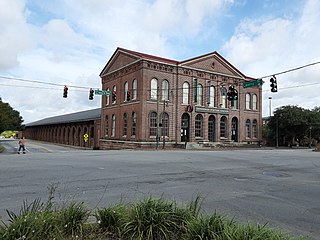
Carl August Schwaab, commonly known as Augustus Schwaab, was a German-American architect and civil engineer. He was principally a designer of commercial architecture, best known for his work in Savannah, Georgia, where he worked for around fifty years.





















